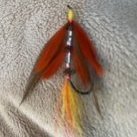
cencalfly
core_group_3-
Content Count
1,396 -
Joined
-
Last visited
Community Reputation
0 NeutralAbout cencalfly
-
Rank
Advanced Member
- Birthday 06/13/1963
Previous Fields
-
Favorite Species
Trout
-
Security
2008
Contact Methods
-
Website URL
http://
-
ICQ
0
Profile Information
-
Location
Central California
Recent Profile Visitors
7,101 profile views
-
Got a a couple bottles on the shelf. Viscosity is kind of perception in these matters. For me, thin rules. Use an application of the thin to actually make the fly durable. Then, dab some thick to give it shine. In the day (my experience only) a shiny super glossy head was not the goal. Although it did make for a nice presentable fly to fishermen. Honestly, there is also a great sense of satisfaction for the tier. Me included. I'm probably not alone in that. Fish may not be so concerned. Realistically though: confidence and durability is very important. Drawing a fish to strike/take is what matters. Today, flash makes for confidence. That matters. Roe or beads work great. Hell, buy a net or maybe some explosives. Please tie without the internet and it's input? Go outside and fish! For Gods sake fish. Use that first hand experience. Observe nature.
-
New Pistol for Precision Shooting
cencalfly replied to cencalfly's topic in Hunting and firearms & Archery discussion
It looks like you may have bought some surplus through the CMP (https://thecmp.org/sales-and-service/1911-information/). Still goes on today but at today's dollars. It's a wonderful score if you get one. The Browning 1911 45 ACP frame and accoutrements is still... That platform has done for America and a lot of the world so much. It is appreciated today by those in precision pistol (AKA Bullseye). It is still required as one of the calibers and platform for competition. What you did in "accurizing" is still done today. Not much has changed there. Just today we buy pistols that best mimic those production models from so many years ago. And, put them through the same accurizing process. The 1911 ACPs held today by the CMP is getting smaller and smaller. Which should be expected. The pedigree or purity is diminished every year. Hold onto them as it is American history. Thank you for sharing. I would like to hear so much more. -
New Pistol for Precision Shooting
cencalfly replied to cencalfly's topic in Hunting and firearms & Archery discussion
I thought about getting a good air rifle for the crows in our neighborhood. Nice and quiet nuisance management. These birds gather for their migration and the skies are thick with them. They'll weigh down the wires and crap everywhere. I also just don't like them (my own prejudices) and urban hunting is frowned upon. I will say that air guns sure have come a long way since the Daisey bb gun and pellet guns of my youth. Air rifles and the calibers out there today have some oomph. I realised in my research people are taking bigger game with them. With that I think the same problem of were the projectile ends up is still of concern. Once it leaves the muzzle the propellent is irrelevant. Isn't it? I've thought about a 22 short. It's quiet and not anymore lethal than some of the air guns out there. It's also simple to make them as quite as a bunny fart. -
Thanks for sharing this trip. The pics and descriptions of your day-to-day were very enjoyable. To next year!
-
Reverse BM Spey Wing Input Sought
cencalfly replied to cencalfly's topic in Artistic & Classic Salmon Flies
Hi Arthur: Yeah I've pulled the BM off the rachis and found bulk feathers. What's good about this method is you don't need matching left and right slips. Just a ton of tying skills which we're working on here. Spey pages did give a lot of good info but as noted above I still feel it was a little short of the mark. Shewey does show a SBS in his book which helps. He also mentions that maybe some skilled tiers of today may resurrect the style. I stepped away to tie some other flies but the adventure continues. -
Reverse BM Spey Wing Input Sought
cencalfly replied to cencalfly's topic in Artistic & Classic Salmon Flies
Thanks Norm. From what I've seen McPhail covers the modern/contemporary way of tying in the wings. I don't know if he has one that hits what I'm trying to do. The closest I've got were videos from Ryan Houston (couple of good vids below). John Shewey references him in his latest book on Spey flies, Their History and Construction. However, I think Houston still does not cover what I'm after. In his reconstruction videos he does not start the wings by tying them in with tips facing forward over the eye. Then folding them back over the body as described by Kelson. Houston does go into the figure eight tying of the BM wing and tying off behind the wing. https://youtu.be/UZf6NzCSjPc?si=ZAuojnKewr71b5JX https://youtu.be/KPBjB0Zvvpo?si=fupnvFtHHSIafPy4 As written by Shewey, Kelson ,and others Shanks and other Speyside ghillies used this technique. The commercial houses of the day reportedly moved away from it. It was difficult and production mattered. If it fished it sold. This may be fool's errand but we all need a hobby. -
cencalfly started following Fall Favorite Freestyle Spey, MacIntyre, Head Cement - Some Casual Research and and 3 others
-
Looks good to me but I don't know what you're after. That's for you. IMHO you have some innate skill. That doesn't seal the deal at all. Lots of practice is necessary to bring it to fruition or get the most out of it. Keep working and honing that skill. You've already lapped most of us.
-
Still have a bottle of Griff's. Good stuff. Presently I use thin Loctite CA glue (superglue) to lock everything in. Then hit it with some Sally's hard as nails to get the gloss. The CA penetrates very well. Actually I have to be careful to not over-do-it. If to much is used it will travel (capillary action?) and goober up the head/collars/throats/whatever. Never went with the modern cements like those offered by Loon or others. Including UV. Just didn't see the need (stuck in my ways). Years ago I used high gloss lacquer. It looked good and penetrated but took more coats. I've also used shellac which looked good too but was brittle. Been thinking about trying out Testors Enamel model paint for certain flies. When I was a kid building models Testors was the kind. Their high gloss enamel was good. There are many color options too.
-
Brads Brat Hook: #7 Alec Jackson Steelhead Iron (gold); Tail: Orange and White Bucktail; Body: ½ Florescent Orange and ½ Florescent Red Angora Goat; Rib: Flat Gold Tinsel; Collar: Brown Hackle; Wing: Orange and White Bucktail. From “Flies for Steelhead” by Dick Stewart and Farrow Allen. Book calls for a gold tinsel tag. I left it off because using the gold hook. I tied a few to compare different body materials. I used wool, seal, and the angora. Looking for a good seal substitute. Angora seems to be a good sub.
-
Hey Arthur: Here's what I'm talking about on the use of BM feather scraps. Not the finest of my dry fly ties but I can guarantee it will get grabs. Whipped it up while watching some golf today. Most of my local Sierra streams and rivers are pocket water and not technical. Maybe I can tie a bunch up and send them to Healing Waters or Rivers of Recovery. It's hard for me to toss any material. I think I have hoarding problem. JP
-
That has been a great trip so far. How much longer you got for his trip?
-
I sit down last night to tie a fly right. Most of my materials are in ziplock or plastic bags and those are in plastic bins. I look over and grab a bin with some capes and saddle patches in it. Hardly any usable feathers in it. None of the ones I needed. Oddly, after looking them over I put them back in the bags and bins. Just couldn't get myself to throw them out. Got online, vented, and put in an order for materials. Of course I couldn't get them all at one place. Getting ready to make another order now. I look at the barring on BM feathers and I see good tailing and wing materials for dry flies. So yeah I do keep those with a use in mind. The story goes that Jim Pray invented the Thor from scraps from the floor. It looks like you got most of the remnants.
-
Put a $1.00 fly-tying feather remnant/leftover on my desk and I struggle. Mental block about waste. Make sense of that. I've been here off and on for a few years. I subscribed to this site in 2008/2009. A lot has transpired since then. It's so weird. In my former profession I could make a centered and well based decision. This happened of course after very careful consideration. We're talking public safety (lives) vs cost type decisions. Never felt comfortable with it: experience, learned science, natural science, and that wild card called people (talk about gambling). After 40 years or so it all worked out. Sort of. Once, young ladies died because they didn't heed the warning signs. Two of them to be precise. Not my project but it was down the hall. Still, I gave input. Young and dumb. All things progress and we try and account for that wild card. Every turn we learn more. There is a cost. Ever squish a bug? Shot or taken an animal? I have on so many occasions. Did you notice that all of them, including the bug, tried to escape. Ran or fought for its dear life. It wanted/needed to survive. Basic instinct. Even the most minor forms of Gods creations desire and fight to live. As it may be the harvest/taking of life is actually part of living. We're apex. That's ok. But what about waste? Something died that fought to save/preserve its life. Again, put a <$1.00 feather remnant/leftover on my desk and I struggle. Make sense of that.
-
I’ve been working on how to tie a BM wing as described by Kelson (pg 101&102 of his book). It’s a struggle to put it lightly. I’m burning through a lot of feathers. Kelson also noted that it takes a lot of practice. That's ok. However, if some sage advice can be shared, I’m all ears. One realization that hit me this evening as I’m rifling through a pile of BM feathers; I don’t need matching left and right feathers for this method. Those are important for the sleek, close to the body, upside-down keel type winging. It’s not necessary for the higher ‘bed-head sexy winging’ (IMHO) seen in many historical photos. I have a Gold Riach body that I’m using to practice winging on. The base as a whole seems somewhat sparse. I stripped one side of the Coq de lon hackle feather as described in the aforementioned Kelson reference. I tied it for the sole purpose of BM winging. Pic below is the base fly and my next slips of BM to try. Please feel free to tell me if they should work or am I going down a wrong path. Hook is a BH #1.
-
I'm not sure where to post this but I wanted to share. Finished this yesterday. An adaptation of Lloyd Silvius's Fall Favorite to a Spey Style/Freestyle Spey fly. Tail is wood duck died hot orange, 2/3 of the body is large silver oval tinsel, 1/3 is hot orange seal dubbing, silver tinsel is wound normal to lock in the hackle, the BEP hackle which wound reverse is two-tone died BEP, collar is red webby saddle, wings are comprised of 2 each left and right saddle hackles; 2 - inner yellow hackles and 2- hot orange outer hackles. Hook is BH #1. Things to fix in my mind. There's a thread wrap on the fourth turn of the flat tinsel tag. My visions is lacking even with jeweler glasses on. Only when photographed and zoomed did I see it. Oh well. The head still needs some work. I see things I don't like. I was looking for a Glasso'esque type profile. Wing length concerns me as what I've seen is kind of all over the map. However, I think it's a good fly and it will swim and fish After looking at it I was thinking a different collar may have added more pop. I have some red dyed Guinee fowl and some red Lady Amherst center tail. Using one of those may have added something. Of course I also like the subtlety of the straight red. I don't know. Maybe the next one. Your thoughts are always welcome of course. I have a good picture of a Fall Favorite tied by Lloyd Silvius himself which I based this attempt on (pic below). Pic of L. Silvius Fall Favorite taken by me at the Golden Gate Angling and Casting Club.





.thumb.JPG.34e862dceb3dd8be4646d978796518d1.JPG)

